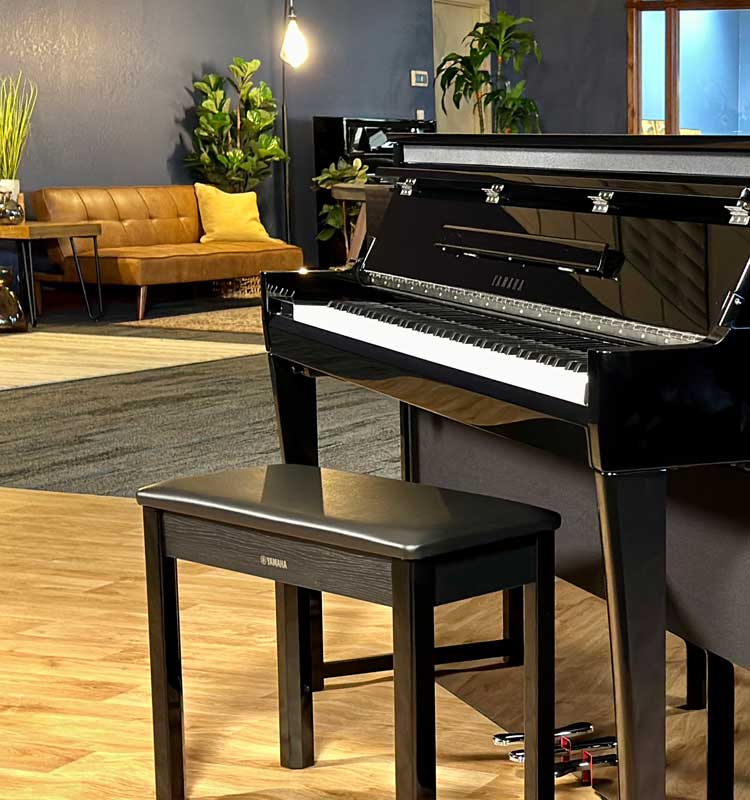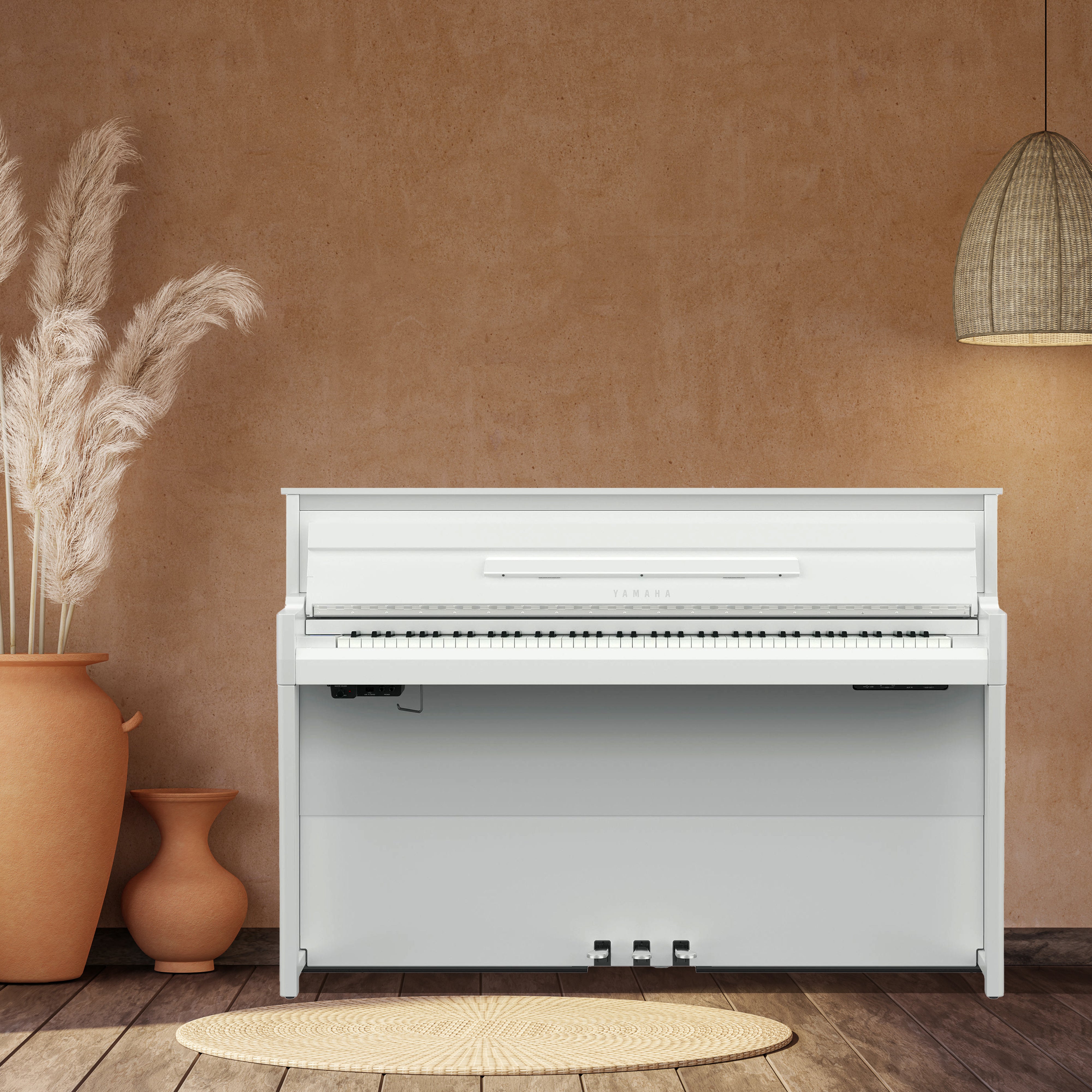The NU1XA has arrived! We quickly unboxed a polished ebony NU1XA and were super anxious to compare it to the polished white NU1X we already had in The Gallery in order to ask the question, "are the differences black and white?" OK, so we had a little fun with the title of this article given that we had two pianos in opposite trims.
I have to tell you that, up front, I was pretty certain that the answer to that question would be "no." I really like the NU1X, and the NU1XA sure looked like it might be a simple refresh of some minor features that might even go unnoticed. The physical design of the new piano is nearly identical to the old, outside of a few subtle differences I'll cover below. A person not familiar with the differences will need to look for the model number on the piano to identify which one they are playing.
Starting with the shape and design, each piano shares the same width and height dimensions (59-1/8" and 40-5/16"), and the NU1XA is just 1/16" deeper at 18-3/16". The NU1XA is actually almost three pounds lighter, but you'll hardly notice or care as it still weighs just over 238 pounds.


As an aside, the NU1XA (like the NU1X) is one of just a handful of digital pianos that arrive to you in their box, completely assembled, just like an acoustic piano. So when it arrives at your home, it's a simple matter of getting a buddy to help lift it out of the box (each piano has integrated grab handles on the rear of the instrument), move it to where you want it, and you're done. Well, that is after you assemble the included bench. But that's the easy part.
Staring at the front of each piano with the lid down, they look identical. Same from the side. Move to the back, and you see a few changes. First, Yamaha now uses an external power supply on the NU1XA, whereas the NU1X had a simple power cord. No big deal there. The rear panel on the NU1X contains two small sound holes near the top of the instrument to bounce sound off the wall that you'll inevitably place it against. The new NU1XA contains four much larger speaker grills back there (two near the top, and two larger ones about mid-piano), and the rear panel is finished a bit nicer. You might not ever notice the rear panel aesthetic change, but about those extra speaker ports? I promise you that you'll notice that… more on the sound and speakers later.
Open the lids of each piano, and surprise – Yamaha has made some real improvements here. First, the power button on the right side of the piano has been upgraded from a taller button to a more modern, flush button. Turn both pianos on, and you then notice that the left side of the piano has completely changed. The NU1X has an intuitive LED numeric display with nine different physical buttons to change things like voices, access the sound recorder, and more. It works fine, but the NU1XA gets a major improvement here as it incorporates a modern touch screen with an LCD display to tell you what sound you are playing or what parameter you are accessing. It's fully lit, which I appreciated right away when playing late one day in a dimly lit room. Touching the screen instantly brightens the display and you can make any changes that you need to without wishing for light. Not so on the NU1X. This may or may not be a deal breaker for you, but for a stage musician, this is a pretty important upgrade. The new display also allows the NU1XA to offer many more parameters for you to change to get the piano sounding the way you desire.


The action… this is one of the major draws to choosing a piano like the NU1XA. Yamaha uses a very complex key action that they simply call "Specialized Upright Piano Action for NU1XA." It feels, to me, exactly like the NU1X. Having seen these pianos with the panels removed, I can attest to the fact that these actions are incredibly authentic in terms of their mechanical moving parts. It doesn't get much closer to the action of an acoustic piano from that perspective.
Where the NU1XA's action differs from the NU1X is not noticed until you power the pianos on and begin to play. The NU1XA features hammer and key sensors that Yamaha calls "Non-contact continuous detection electromagnetic inductive type," whereas the NU1X simply features key sensors that they call "Non-contact optical fiber." OK, so how does that translate to the feel? I sat and played the NU1XA for a good 30 minutes before moving over to the NU1X that I've been familiar with for a few years, and I dare say that the difference was substantial! This difference will be undetected to a novice, I'll bet. But as someone who has played for most of my life, and (being in the business) having literally played many, many hundreds of different digital piano models, it became quite obvious that Yamaha's engineers have succeeded in improving what was already an excellent action. There just seemed to be more refined response points, meaning I could play softer, louder, and just be more expressive on the NU1XA. Fun!
As for the sound, that is an improvement as well. Remember those extra speaker ports I mentioned earlier? Yamaha includes essentially the same amplifier in both pianos with the NU1XA having (40 watts + 45 watts) x 2, and (45 watts + 45 watts) x 2 on the NU1X. Actually surprising that the new model has slightly less power. But the NU1XA features a 16 centimeter + 2.5 centimeter (x 2) speaker system with domes and bidirectional horns. This really makes the piano sound more alive and more capable of reflecting the many, many parameters that the player can change, like Reverb, Brilliance (7 types on the NU1XA, none on the NU1X) and all of the cool edits one can make by touching the "Piano Room" button (edit the lid, brightness, touch, reverb depth, damper noise, string resonance and much more).
A few other subtle differences:
| Model | NU1XA | NU1X |
|---|---|---|
| Voices | 28 | 15 |
| Touch Sensitivity | Hard2/ |
Hard/ |
| Recording # of songs | 250 | 10 |
| Recording # of tracks | 16 | 1 |
| Brilliance | Yes (7 types) | No |
| Binaural Sampling | Yamaha CFX Grand and Bosendorfer | Yamaha CFX Grand |
| Piano Room Editing | Yes | No |
| Amplifiers | (40 W + 45 W) x 2 | (45 W + 45 W) x 2 |
| Speakers | (16 cm + 2.5 cm (dome) with Bidirectional Horn) x 2 | (16 cm + 1.9 cm) x 2 |
Do I think the differences between the two pianos are black and white? I do. I certainly wasn't expecting to answer like that, but the more I play the new one, the more I'm drawn to it. As I said, I'm not sure everybody will agree or be at an experience level where they will notice. But boy, as a player and one who can appreciate the nuances of tone, touch, and expressiveness, the NU1XA is a winner.









YOUR MUSIC TECHNOLOGY STORE SINCE 1984